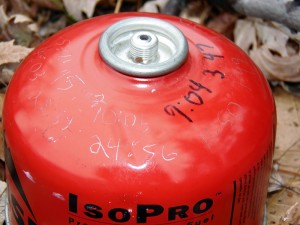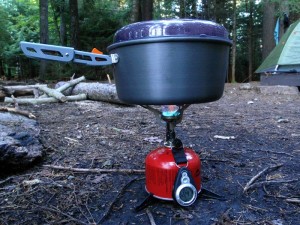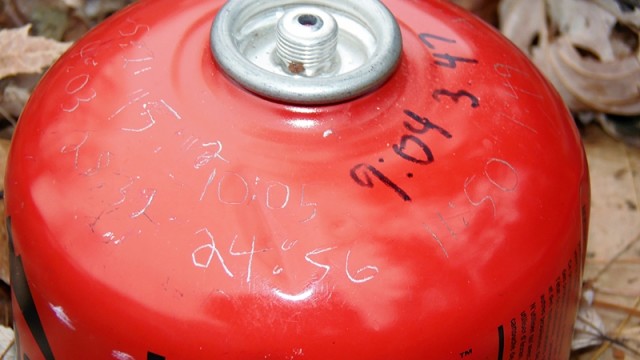
There’s no doubt that isobutane fuel canister stoves are so popular because they are easy to use, clean burning, and have a low stench factor. But, at the same time, they’re relatively bulky and heavy compared to just carrying a fuel bottle. And one of their more irritating characteristics is that we’re often unsure how many we have to carry on any given trip. Sure, we’ve all seen specs for “1.5 hours on high”, or the like; but at what ambient temperature, and what if you actually cook with your stove rather than just boiling water?
Our standard fuel canister for testing stoves is the MSR IsoPRO 8 ounce. While we haven’t actually done a full test of different brands of canisters, the MSR has performed well at all times, and is the most consistently available at different stores in our area. So, we grabbed a new one and headed into the field with it. We boiled water in the morning for our coffee and tea; we cooked eggs for breakfast; we heated water for washing up; we sauteed little trout we caught for lunch along the way; we cooked dinner–sometimes several courses for dinner. Sometimes it was on high, sometimes medium, and sometimes even on as low as we could make it go to avoid burning something.
And, we intentionally used different stoves; after all, this was a test of the way the fuel canister would work in the real world, not the test of a particular stove/pot combination. So, a Jetboil Sol and MSR Reactor were pressed into service for heating water; a Primus Express was the choice for general cooking duties; and when the temperature dropped below freezing, we inverted the canister on a Coleman Fyrestorm Ti using the Powermax Fuel Adapter and used it as liquid fuel. We used the same canister in hot weather, then took it back out in cool weather in the early fall, then back one more time for a winter backpacking trip.

And, each time, we timed our use of it from the moment we turned it on to the moment we turned it off, and then scratched the time into the paint on the canister (okay, we started with a Sharpie, but decided that was a dumb idea, particularly the first time the canister was wet).
And…the answer is? Total run time for all uses was 3 hours, 1 minute, 29 seconds. Quite a difference from the typical run time spec given on a stove’s box; those tend to be closer to an hour. Now, if you’re a Ramen ultralighter who only boils water to make those noodles soft enough to slurp, you won’t get even close to that much time out of a fuel canister. But, for those of us with mixed uses, it makes it pretty clear that for a few nights out, we don’t need 3 fuel canisters. And, knowing that 8 ounces of fuel is typically going to last us around 3 hours, and that the empty canister weighs 4.6 ounces, it gives us a guide for what we can expect from a partially used fuel canister. We weigh them before a trip and mark the amount of fuel; if it weighs 9.7 ounces, we’ve got roughly 5.1 ounces of fuel. Each ounce of fuel is good for about 23 minutes, so that canister’s got better than an hour and a half left of our “typical” use.
Is this a highly scientific method? Nope, and it frankly can’t be, as the way you use a fuel canister will obviously affect its lifespan. We might get 4 hours out of one, and 2 out of the next. You might always get 3, or 2 or 1.5 out of yours, But…at least it’s a guide that helps figure out how useful those partially used canisters are…it’s better than hefting one and guessing that it might be a quarter full and that might be good for…10 minutes? 10 hours? Since we started this project, we’ve found that we’re more confident taking our partials on trips without QUITE as many backup bottles. Give this a try with one of your canisters, and we’re betting you’ll feel the same way!



Thank you, for the detailed information.
Really great article. So helpful and informative. Thanks!
You mention weighing the canister to determine fullness… I just switched to Iso Butane I used to use coleman fuel back in college and just bought new gear to start back up.
Not sure if stuff changed since you read the article.. BUT…
http://www.advdesigns.com/msris8ozclbu.html?gclid=Cj0KEQiA592lBRCXy8yl4bjK17wBEiQAg1Az_dR6HnxR9FXIIl6BU2bwTE1P5kBeSslWLjqzf3PJJngaAngU8P8HAQ
to the left of the MSR Iso Pro label you can see a pic of the canister in water… and an E and F with lines between them… float a full canister… it lines up with F… as you use gas the weight of the canister changes but it’s volume does not so it’s buoyancy changes… which is reflected in how deep it sits in the water giving you a gauge.
This is handy because you can measure it out in the woods… or in your kitchen sink.
I was fairly impressed by that… not sure how recent the labeling changed but it’s awesome…
Chris, great comment…thanks! Yes, the float gauge on the MSR canisters is fairly new; in fact, we recently saw some of the old canisters in a store. So, if you’re using their canisters, you’re set. But, there are a number of brands out there, and while you could probably try to guess how much is in them by a float test, weighing them is still more accurate. But, the industry keeps evolving, so who knows what we’ll see next!
I assume you have to tip it sideways as you submerse it so there is no air trapped underneath?
chris
Thanks for sharing yhat info. My wife (58) and myself (64) heading out on a 30 mi backpack/flyfishing hike
we figure will take us 7-8
days.
We really had no realistic idea what to expect from
an 8 oz cannister.
Thanks to you we now are much more confident
as you have given us a
much better feel for what
cook times to expect.
Good job. Dgl
Thank you, David! Years ago, I took my daughter on a camping/fishing trip, and ran out of fuel…no fish for dinner. Hope you eat well!
Great article, thanks. I just ordered a Reactor, to replace or use as an alternative to my Svea 123. I get tired of the priming and preheating, and am intrigued after all these years by the convenience and efficiency of the new canister stoves. Given the choice between the Reactor and the Svea, which would you take on an XC ski trip in Yosemite in January?
By the way–how can you run out of fuel on a fishing trip? I usually cook my trout on a stick over a small fire, like a hot dog!
Tim, You didn’t mention whether you’ll be camping on your Yosemite tour or just carrying the stove for day/emergency use, which would possibly affect things.
I’ve been using the MSR Reactor to make my morning tea for a number of years now, love it (though I wish it had a Piezo ignitor), consider it standard equipment. But IF (and this is a big IF) I was thoroughly familiar with the Svea 123 and all its myriad little quirks, I’m not sure I’d choose the Reactor over the Svea for an extended winter backcountry trip. Here’s why:
1) In my experience, no “upright” canister stove works very well in deep cold. You have to warm the canister somehow; carrying it inside your jacket, for example, or putting a hand warmer pack next to the canister in your pack. White gas, on the other hand, always lights. Both stoves work better if you set them on a square of foam to insulate them from the snow, so that’s a wash.
2) The Reactor is pretty much a Johnny One Note: it heats water fast. You can’t cook on it. The Svea is slower but more versatile.
3) For an extended trip, fuel for the Svea is easier to carry, though spilled fuel is dangerous and getting any on your fingers is a recipe for instant frostbite.
Here’s my final advice: Try the Reactor on some easy trips where you can also carry the Svea. See which works better for you.Go with it (and maybe consider an Esbit stove as a backup?)
Hope this helps. Let us know which you choose and why. It’s another datapoint in an endless quest for answers.
I’ve used one of the 8-ounce canisters the last couple weeks for boiling 16 ounces of water to make coffee and tea. So far, I’ve boiled 3.4 gallons in total and believe there’s enough left in the tank to get to 4. These things are great.
Warning re: SVEA stove. The gasket on the fill cap failed (age), which resulted in a leak, which resulted in a huge fireball that burned until the tank ran out of fuel. This once left me stranded on a long remote trip with no way to cook my food.
Lesson 1: Operate stove away from tents, backpacks etc.
Lesson 2: Carry a spare replacement gasket.
Kevin, that’s one of the reasons for canister stoves; no infamous white gas fireballs. It’s one of the things we warn winter backpackers about; it’s cold, so they want to just stick their hands out of the tent and light the stove, and they HAVE to use white gas, since canisters won’t work well below freezing. Glad you survived the explosion!
Really great article and comments all round.
We were thinking about this issue a while back and decided to create a “Gas Canister Calculator” to allow people to fairly accurately estimate how many gas canisters they will need (and whether small, medium or large) based on number of people, number of days, hot water requirement and type of stove (canister top, integrated and remote canister).
We calibrated for our three different class of gas canister stove with data from real outdoor usage over several years (rather than using unrealistic laboratory data).
Our calculator enables you to change various variables e.g. type of stove, size of canister, to work out the optimum stove and canister combination for your trip.
Check it out here: http://mercatorgear.com/index.php/frequently-asked-questions/canister-calculator
Any feedback, or suggestions or questions would be welcome. Meanwhile, we hope this is useful, and keep up the great work!
Nice to know that there’s someone out there who can out-geek us! A note to readers: Their calculator only works with the specific stove named, and it’s specifically geared to hot water, so it’s of limited value for general cooking, but…play away!
Hi David, thanks for your feedback and I’m glad you appreciate our geekery! And yes you are right that our calculator is calibrated for our KOVEA stoves; these are the ones we have collected real usage data about, so we know it’s pretty accurate. However, the numbers should broadly be in line with what to expect from other quality stove brands, so you could certainly use the Gas Canister Calculator for stoves from MSR, SnowPeak, etc.
We calibrated for boiling water, as this is a very standard measure which you can repeat in many different conditions. How much gas you use for making an omelette or frying bacon, is more difficult as it’s more subjective and there are more variables. John over at Flatcatgear.com might be able to help with that as he’s a pretty awesome backcountry chef.
Anyway, I hope this helps, and have fun with the calculator!
Cheers. Steve
We are an outfitter looking to change from white gas use to isobutane for our customers. A calculator for estimating fuel use with a variety of group sizes would help. How do I get a calculator?
Steve, that’s WAY outside of our area of expertise…we’ve seen caculators online, but can’t comment on their accuracy. What we CAN say is that it’ll be an expensive switch for you; we love isobutane canisters for a lot of uses, but when we’re going to be burning a lot of fuel, we either use white gas or those large propane bottles that you can get at the local grocery store…they’re the fuel of choice for car camping.
I’m confused by this statement: “Now, if you’re a Ramen ultralighter who only boils water to make those noodles soft enough to slurp, you won’t get even close to that much time out of a fuel canister.”
Are you saying it takes more fuel/time to boil water for ramen thats barely cooked than it does to sautee fish etc?
Great question, Courtney! And, the answer is…yes, it takes more fuel per minute to boil Ramen than it does to sautee fish. This is about how long the CANISTER will last, not how long your specific meal prep will take. If you saute fish on a low flame, the canister will last many times longer than if you’re using it in blowtorch mode to boil water. Now, will you get more MEALS out of a canister? Likely not…but if all you do is sautee, the “canister lasts 1 hour” goes right out the window, as it’ll last many times that. Did that clear it up?
You don’t need to cook ramen. Ramen is pre-cooked and dehydrated. You could eat it cracker-dry or just soak it until it’s soft.
N1, really appreciate this article & the adjoining comments – learnt a lot & looking forward to doing my own field tests.
My thanks.
Thanks David ,
It was really a very good article and helped me to figure out how much canister do I need for a trip 🙂
I am quite confident now about the number of canisters do I need for my trip. Definitely will try to check the weight and usauage and how long they last.
David,
As a first time user of an MSR Windburner 1 litre stove system on a planned 17 day hike with no possibility of additional gas supplies, I found your research and article to be really helpful.
The MSR website is very helpful, and your research confirms their gas consumption figures, so I can start trekking with confidence knowing that I won’t end the hike eating cold dehydrated food.
I had planned to take almost 3 times as much gas (and weight) compared to what I am likely to need based on your findings. With the benefit of your research I can cut this in half and still have quite a lot of spare gas as a contingency. This will save me a lot of unneccesay weight and will really help.
Thanks, Phil (Australia)
I am looking at using one of these for my motorcycle camping trips… weight doesn’t matter but size does. Thanks for all the great info!
I have a Soto pressure regulated stove, at jet engine afterburner rate, it brings 1 cup of water 1.5 mins to boil (with an olicamp 1l pot with grilled base) using 1 oz per 1.5l of water. Therefore scaling up a 4 oz tin of fuel will bring 6l of water to a boil. Container was weighed before and afteruse.
Useful information, Paul! One thing that would be fascinating to see (if you felt like wasting a canister) would be to boil 4 1.5L pots and see if the pressure regulation works the same as the canister empties. We’re assuming that you’re boiling at somewhere close to sea level at somewhere close to 70 degrees F…while pressure regulated stoves are supposed to take the effect of altitude pretty much out of the equation, we haven’t been able to do controlled tests to prove that. If you do decide to try that, please let us know the results!!!
Our cook system is now very simple. We realized we don’t drink hot fluids and eat at the same time, so our only “dish” is a GSI infinity mug. We boil water in a Evernew 900ml mug pot. (230g canister fits perfectly in the pot).
Dry food goes in the GSI mug first, then boiling water is added to the GSI mug for rehydration. We may have a hot chocolate after the meal. Same process in the morning. The only items that need food cleaned off are a spoon, and the GSI mug.
i found an aluminum splatter screen at an asian food market, it is a trifold, folds flat and fits the stove/pot perfectly for a windscreen. I can tilt it and lean it against the pot so there is plenty of air flow around the base of the canister to make sure it doesn’t get hot (never does BTW), but still blocks the wind and keeps heat around one side of the pot. The stove head is a primus express with piezo lighter. Lighter still works great after six years.
Our typical situation is boiling water at about 4000′ elevation, and a water temperature of about 50 degrees F (water temp is just a guess)
To boil one cup of water I typically start it at a low setting and run it for about a minute, then turn it to a high output for about another minute.
After several outings, and careful tracking of fuel used (weigh canister before/after trip), we very consistently boil 2.06 pints of water per gram of fuel used.